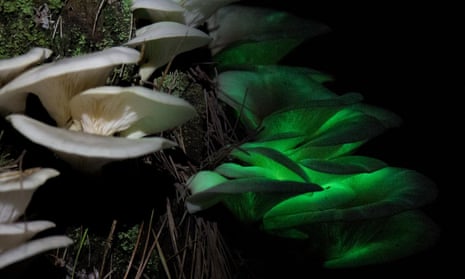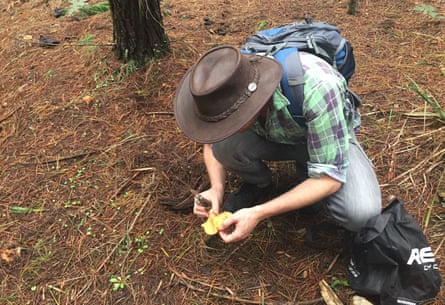Standing in a dark pine forest surrounded by bioluminescent mushrooms is as magical and mysterious as it sounds – and worth the midnight trek into the mountains three hours out of Sydney

Composite image of the Ghost Fungus, Omphalotus nidiformis, in natural light and glowing in the dark. Photograph: Nick Evershed/The
It’s just before midnight and we’re in the middle of an eerie pine forest in the Blue Mountains of New South Wales, dodging leeches and lugging heavy camera equipment.
We’ve driven three hours from Sydney at night just to find and photograph one thing – Omphalotus nidiformis, commonly called the Ghost Fungus.
With the wet, increasingly cold autumn, the national parks and state forests on Australia’s east coast have exploded with colourful fungi. It’s a good time for bushwalking and foraging.

The author foraging for saffron milk caps while doing his best Les Hiddins impression
I’d been out collecting the edible saffron milk cap (Lactarius deliciosus) up near Oberon when I spotted an interesting-looking oyster-mushroom-like species, predominantly growing on dead wood. I later realised this was the Ghost Fungus, a species mostly known for its bioluminescent properties – that is, it generates its own light, glowing faintly in the dark.
I convinced some friends to come back with me at night to photograph the mushroom. Here, you can see the results of the photos, animated to fade from how they look in natural light to how they look when illuminated from within by their own light.
Bioluminescence has always been fascinating to me. At night, it’s magical and mysterious – from blue glowing waves in the ocean (caused by Noctiluca scintillans, a tiny plankton), to drifting fireflies in the jungle, to galaxies of glow-worms on the roof of a cave.
Even when you know some of the science behind bioluminescence, it’s no less fascinating. In the case of O. nidiformis, scientists aren’t even too sure why it glows. The chemical pathway is well-known – a compound generically known as luciferin is oxidised in the presence of an enzyme, luciferase, which produces light – but the reasons, from an ecological perspective, are less clear.



One theory, which seems likely in other species, is that glowing fungi attract insects that then disperse spores, helping propagate the fungus. Scientists tested this theory with a Brazilian bioluminescent fungus in a fascinating study that involved, among other things, making fake mushrooms with LEDs attached for illumination.
However, a 2016 study of O. nidiformis by scientists from the University of Adelaide found that this probably isn’t the case with the Ghost Fungus, as they found insects weren’t attracted to traps containing glowing mushrooms any more than traps without mushrooms.
Instead, the researchers speculated that the bioluminescence may just be incidental. That is, the chemicals that produce the light may have some other role beneficial to the fungus and the glowing is merely a byproduct of this.
Regardless of the science involved, standing in the middle of a dark pine forest surrounded by clumps of dimly glowing mushrooms is an amazing, wondrous thing.
How to find the Ghost Fungus
First of all, the Ghost Fungus is poisonous, so please do not eat it. The best time to look for it is in autumn, particularly after a bit of rain.
According to the Atlas of Living Australia, it occurs down the southern east coast of Australia, as well as Victoria, Tasmania, and the southern parts of Western Australia and South Australia. It generally grows on tree trunks and stumps, and is particularly easy to spot in pine forests, as there is less understorey.
Carol Probets, a birding and nature guide from the Blue Mountains, says the easiest time to find it is actually in the daytime.
“If you learn to recognise it in the daytime, it’s much easier to find it in the daytime rather than wondering around in the dark,” she says.
Tips for photography
Photos of O. nidiformis glowing are somewhat misleading, as to the naked eye the light emitted is quite dim and blueish-white. To see the light emitted over a longer period you’ll need to have a tripod and a camera capable of taking long-exposure photos, like a digital SLR.
If you have a remote control for shutter release, you can set a long exposure time (probably around a minute or more, depending on your other settings) that will allow you to have a lower ISO and greater depth of field. This is good because the shot will be less grainy than it might be with a shorter exposure time.
If you don’t have a remote shutter release control, your exposure time will be limited to the longest camera default (in my case this was 30 seconds), in which case having a fast lens and high ISO becomes necessary, and some cleanup of noise will be required after taking the photos.
The settings I used for the glowing photos above were: f4, ISO 5000 and a 30-second exposure.
Probets, who has also taken long-exposure photos of the mushroom, says the hardest part is focusing.
“Use torchlight to focus manually, then do your long exposure,” she suggests.








